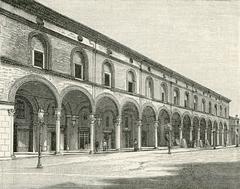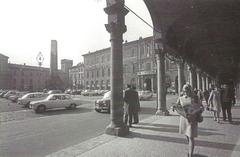Monumento al II Corpo d’Armata Polacco: Visiting Hours, Tickets, and Historical Sites in Imola, Italy
Date: 14/06/2025
Introduction
The Monumento al II Corpo d’Armata Polacco in Imola, Italy, stands as a poignant tribute to the courage and sacrifice of the Polish II Corps, a distinguished Allied force that played a decisive role in liberating Italy from Nazi occupation during World War II. Located in the historic Emilia-Romagna region, this monument not only commemorates military achievements but also embodies the enduring spirit of international solidarity, freedom, and the deep Polish-Italian friendship forged during the war. This comprehensive guide provides in-depth historical context, detailed visitor information, and practical travel tips for those wishing to explore this significant site and its surroundings.
For further reading, explore 2korpus.org, Visitare Imola, and Company of Heroes History.
Table of Contents
- Introduction
- History and Significance of the Monument
- Formation and Role of the Polish II Corps
- Leadership and Campaigns
- The Liberation of Imola
- Monument Features and Symbolism
- Visitor Information: Hours, Tickets, Accessibility
- Guided Tours and Events
- Travel Tips and Nearby Attractions
- Cultural and Educational Value
- Community Engagement and Commemorations
- FAQs
- Conclusion and Call to Action
- References
History and Significance of the Monument
The Monumento al II Corpo d’Armata Polacco honors the Polish II Corps, formed in 1943 under General Władysław Anders. This force, composed of soldiers who had survived Soviet imprisonment and displacement, became a formidable Allied unit in the Italian Campaign. Their most renowned victory was at Monte Cassino in May 1944, a turning point that broke the German Gustav Line and paved the way for the liberation of cities such as Imola and Bologna.
The monument, located in the Giardino Generale Anders, is more than a war memorial. It represents resilience, sacrifice, and the shared quest for liberty between nations. Its symbolic elements—such as the Polish eagle and the statue of Wojtek the Bear, the Corps’ famous mascot—capture the spirit and camaraderie of those who fought for freedom (Comune di Imola).
Formation and Role of the Polish II Corps
Established in 1943, the Polish II Corps consisted largely of former Soviet prisoners released after the Sikorski-Mayski Agreement. By 1944, it included around 50,000 soldiers from diverse backgrounds and grew to about 75,000 by 1945, reinforced by Polish POWs and conscripts from the Wehrmacht. The Corps comprised divisions such as the 3rd Carpathian Rifle Division, 5th Kresowa Infantry Division, and the 2nd Warsaw Armored Brigade (Wikipedia).
Leadership and Campaigns
General Władysław Anders, a symbol of Polish resilience, led the Corps through grueling campaigns. Under his command, the unit earned a reputation for determination and effectiveness, notably during the fourth Battle of Monte Cassino. After this victory, the Corps advanced through Ancona, breached the Gothic Line, and liberated Bologna, where they were the first Allied troops to enter the city (Warfare History Network).
The liberation of Imola on April 14, 1945, was another key achievement. Polish patrols entered the city, ending German occupation and marking a milestone in the Allied campaign in Italy (Comune di Imola).
The Liberation of Imola
Imola’s liberation by the Polish II Corps is commemorated as a moment of international solidarity. The city’s gratitude is expressed in annual ceremonies and community events. The Polish contribution to Imola’s freedom is a central part of its collective memory, reflected in the city’s status as a Gold Medal City for Military Valor in Partisan Activity (Leggi la Notizia).
Monument Features and Symbolism
Main Memorial
The main monument, created by Luigi Enzo Mattei and inaugurated in 2005, features a bronze sculpture on a tall stele. It represents the encounter between Polish liberators and local citizens, symbolizing peace and reconciliation. Its location marks the route of the first Polish patrols entering Imola (Pietre della Memoria).
Wojtek the Bear
Next to the main monument is the statue of Wojtek, the Syrian bear adopted by Polish soldiers and made famous for helping carry ammunition during the Battle of Monte Cassino. Unveiled in 2015, this statue is the first of its kind in Italy and stands in the Giardino Generale Anders, near the Chiesa della Coraglia (Kresy Family).
Symbolic Elements
- Polish eagle: Symbolizes national pride and the indomitable spirit of the Polish people.
- Inscriptions: Phrases such as “Per la nostra e la vostra libertà” (“For our freedom and yours”) encapsulate the values and international legacy of the Corps.
- Commemorative plaques: List battles and names of fallen soldiers, inviting reflection and remembrance.
Visitor Information: Hours, Tickets, Accessibility
- Location: Giardino Generale Anders, Via della Resistenza, Imola. Close to the Santuario della Beata Vergine della Coraglia.
- Visiting Hours: Open daily, year-round, from dawn until dusk.
- Admission: Free entry; no tickets required.
- Accessibility: The park has paved, level pathways and is wheelchair accessible. Benches are available for rest, and there is bilingual signage (Italian and Polish, with some English).
- Facilities: No restrooms on site, but public facilities are nearby. Parking is available but may be limited during major events.
- Getting There: Reachable by local bus, a 15-minute walk from Imola train station, or by car.
Guided Tours and Events
- Guided Tours: Available through the Imola tourist office or local historical associations, especially during special events.
- Annual Commemorations:
- April 14: Main liberation anniversary, with ceremonies, speeches, and wreath-laying.
- November 11: Polish Independence Day, marked by smaller events.
- Other WWII anniversaries: Occasional remembrance gatherings enhance the visitor experience.
- Educational Activities: School groups and cultural associations frequently visit, using the monuments as starting points for historical education and intercultural dialogue.
Travel Tips and Nearby Attractions
- Combine your visit: Explore other Imola historical sites such as the Rocca Sforzesca fortress, San Domenico Museum, and the Museo Nazionale della Resistenza (thesilvernomad.co.uk, Museo Nazionale della Resistenza).
- Best time to visit: Spring and early autumn offer pleasant weather and coincide with key commemorative events.
- Photography: Permitted at the site—be respectful during ceremonies and when others are present.
- Dining and accommodation: Imola’s city center, nearby, offers restaurants and hotels suitable for travelers.
Cultural and Educational Value
The monument and its surroundings serve as a living classroom, fostering historical awareness and international solidarity. Interpretive panels and brochures are available at the site and through the Associazione Eredità e Memoria. These resources provide context on the Polish II Corps’ journey, the liberation of Imola, and the enduring friendship between Italy and Poland.
Community Engagement and Commemorations
The site is integral to Imola’s civic identity, with local organizations and the Polish community actively involved in annual commemorations. Educational institutions and cultural associations help keep the memory of these events alive through exhibitions, music, and art, ensuring that the story of the Polish II Corps continues to inspire future generations (Comune di Imola).
Frequently Asked Questions (FAQ)
Q: What are the visiting hours of the Monumento al II Corpo d’Armata Polacco?
A: The park and monuments are accessible daily from dawn to dusk, year-round.
Q: Is there an entrance fee or ticket required?
A: No, entry is free and no tickets are needed.
Q: Are guided tours available?
A: Yes, guided tours can be arranged through the Imola tourist office or local associations, especially during commemorative events.
Q: Is the site wheelchair accessible?
A: Yes, there are paved, level pathways and accessible monuments.
Q: Can I take photographs at the site?
A: Yes, photography is permitted but please be respectful, especially during ceremonies.
Conclusion and Call to Action
The Monumento al II Corpo d’Armata Polacco in Imola is a powerful testament to courage, sacrifice, and international friendship. Its accessible location, rich educational resources, and vibrant commemorative culture make it a must-visit for anyone interested in World War II history or cultural heritage. Plan your visit to connect with a pivotal chapter in Italian and Polish history, and consider exploring related sites throughout the region for a fuller appreciation of the Allied campaign in Italy.
Download the Audiala app for guided audio tours and up-to-date information on Imola’s historical sites. For the latest events and commemorations, follow local heritage organizations and check official websites.
References
- Company of Heroes History
- Visitare Imola
- Comune di Imola
- Associazione Eredità e Memoria
- Polish History
- Warfare History Network
- Museo Nazionale della Resistenza
- Il Nuovo Diario Messaggero
- Pietre della Memoria
- Kresy Family
- WhiteMAD
- Associazione Eredità e Memoria
- Leggi la Notizia
- The Silver Nomad


